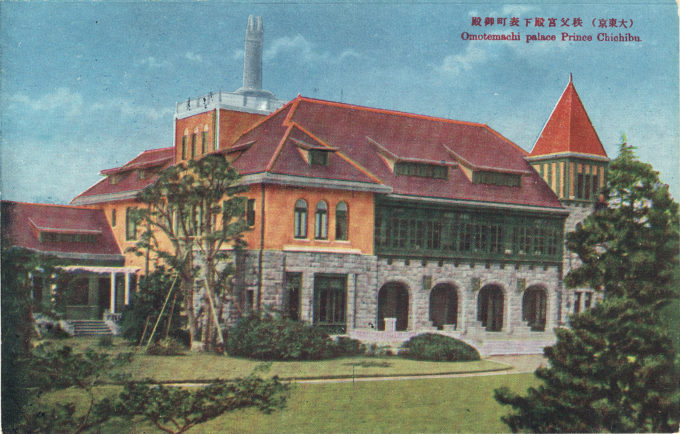“Prince Chichibu [Emperor Showa’s younger brother] was commissioned as a second lieutenant in 1922, after three months as a provisionary officer. A palace had been built for him in Akasaka’s Omote-cho, and he moved into it that same year.
“It was a little over a mile from his office, and he insisted on walking the distance. As people he passed bowed to him, he never failed to return the courtesy. And he was so punctual that people on his route said they could set their watches by him!”
– Prince and Princess Chichibu: Two Lives Lived Above and Below the Clouds, by Dorothy Britton & Princess Chichibu, 2010
See also:
Togu Gosho (Crown Prince’s Palace), c. 1920.
Akasaka Detached Palace, c. 1920-1950.
Imperial Palace (Meiji Palace) interiors, Tokyo, c. 1920.
“Yasuhito, Prince Chichibu (1902–1953) was the second son of Emperor Taishō (Yoshihito) and Empress Teimei (Sadako), a younger brother of Emperor Shōwa (Hirohito) and a general in the Imperial Japanese Army. As a member of the Imperial House of Japan, he was the patron of several sporting, medical, and international exchange organizations.
“He attended the elementary and secondary departments of the Gakushuin Peers’ School along with Crown Prince Hirohito, and his younger brother, Prince Nobuhito (born in 1905). (A fourth brother, Prince Takahito, was born in 1915). Prince Chichibu enrolled in the Central Military Preparatory School in 1917 and then in the Imperial Japanese Army Academy in 1922.
“In 1925, the Prince went to Great Britain to study at Magdalen College, Oxford. While in Great Britain King George V decorated Prince Chichibu with the Grand Cross of the Royal Victorian Order. Prince Chichibu had a reputation as an outdoorsman and alpinist during his stay in Europe. He returned to Japan in January 1927 following the death of Emperor Taishō, who for some time had suffered from debilitating physical and mental ill-health. Until the birth of his nephew Crown Prince Akihito in December 1933, Prince Chichibu was heir presumptive to the Chrysanthemum throne.
“Prince Chichibu received his commission as a second lieutenant in the infantry in October 1922 and was assigned to the First Imperial Guard Division. He was promoted to first lieutenant in 1925 and became a captain in 1930 after graduation from the Army War College. He received a promotion to the rank of major and assigned to command the Thirty First Infantry Division stationed at Hirosaki, Aomori in August 1935.
“The prince was a vehement ultra-right-wing militarist who increasingly influenced Japanese military policy in the prewar era, and has been implicated by some historians in the abortive 26 February Incident in 1936. How much of a role he actually played in that event remains unclear, but it was clear that he was sympathetic to the rebels and that his political sentiments were in agreement with them, i.e., replacement of the corrupt political party based government with a military dictatorship under direct control of the emperor. His sympathy to the Kodoha faction within the Imperial Japanese Army was well known at the time.
“After the assassination of Prime Minister Inukai Tsuyoshi in 1932, the prince had many violent arguments with his brother, Emperor Hirohito, about the suspension of the constitution and the implementation of direct imperial rule. He was convinced that the future of Japan was linked to Nazi Germany and in 1938 and 1939, he had many quarrels with the Emperor about the opportunity to join a military alliance with Germany against Great Britain and the United States.
“In a book about ‘Yamashita’s gold’ (Gold Warriors: America’s Secret Recovery of Yamashita’s Gold, 2006), authors Peggy and Sterling Seagrave postulated that Prince Chichibu led from 1937 to 1945 what the authors called the ‘Golden Lily Operation’ (Kin no yuri) by which members of the Imperial Household allegedly were personally involved in stealing treasures from countries invaded by Japan during World War II.
“But these allegations are contrary to a version told in her memoirs by Princess Chichibu (Setsuko), according to which the prince retired from active duty after being diagnosed with pulmonary tuberculosis in June 1940, spent most of World War II convalescing at his villa in Gotemba, Shizuoka Prefecture, on the eastern foot of Mount Fuji and never really recovering from his illness.
“Prince Chichibu died from tuberculosis at his Kugenuma villa in Fujisawa, Kanagawa on 4 January 1953.”
– Wikipedia


